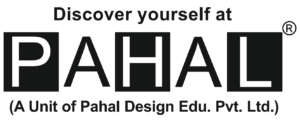IIT UCEED
 Pahal Design is a national level test preparation coaching institute in India for design entrance examinations, which are held nationwide. With the team of design industry experts, Pahal Design is shaping the career of thousands of students at national level in design. Regular classroom program, crash course, printed study materials & online test series for preparation of IIT UCEED exam are offered at all of our study centres. We are having our classroom centres in Delhi, Bangalore, Ahmedabad, Mumbai, Kolkata, Pune, Gurgaon, Lucknow, Kanpur, Allahabad, Varanasi, Bhopal, Indore, Patna, Ranchi and Dehradun.
Pahal Design is a national level test preparation coaching institute in India for design entrance examinations, which are held nationwide. With the team of design industry experts, Pahal Design is shaping the career of thousands of students at national level in design. Regular classroom program, crash course, printed study materials & online test series for preparation of IIT UCEED exam are offered at all of our study centres. We are having our classroom centres in Delhi, Bangalore, Ahmedabad, Mumbai, Kolkata, Pune, Gurgaon, Lucknow, Kanpur, Allahabad, Varanasi, Bhopal, Indore, Patna, Ranchi and Dehradun.
ABOUT IIT UCEED
Admissions to the Bachelor of Design (B. Des) programmes at IIT Bombay, IIT Delhi, IIT Guwahati, IIT Hyderabad, IIT Roorkee and IIITDM Jabalpur are done through the Undergraduate Common Entrance Exam for Design (UCEED). Many institutes also recognize the UCEED Score Card for admissions to their B. Des program. Only those students who have passed Class XII (or equivalent) in 2023 in all subjects or are appearing in 2024 in ANY STREAM (Science, Commerce, or Arts & Humanities) for the first time are eligible to appear for the UCEED 2024
UCEED 2024 PARTICIPATING INSTITUTES
- Indian Institute of Technology Bombay (IITB),
- Indian Institute of Technology Delhi (IITD),
- Indian Institute of Technology Guwahati (IITG),
- Indian Institute of Technology Hyderabad (IITH),
- Indian Institute of Technology Roorkee (IITR)
- Indian Institute of Information Technology Design and Manufacturing Jabalpur (IIITDMJ)
Question Paper Structure
- There will be ONE question paper of total THREE hours duration.
- The question paper will be in English only.
- The question paper will carry a total of 300 marks.
- The question paper will consist of two parts: Part-A and Part-B. It is compulsory to attempt questions from both parts.
- Utmost care is taken to prepare an error free question paper. However, if an error is detected in the question paper, the UCI Committee shall take an appropriate decision after the examination, which shall be final.
Details of the two parts of the question paper are given below: Part-A (Total marks: 200; Maximum time: 2 hours)
- This part will be administered through a computer-based test.
- This part will consist of three sections.
Section 1: NAT (Numerical Answer Type): 14 questions (4 marks each; no negative marks). For these questions, the answer is a number that needs to be entered using a virtual keyboard on the computer screen. No choices will be shown for these questions.
Section 2: MSQ (Multiple Select Question): 15 questions. Each MSQ may have one or more than one correct choice(s) out of the four given. The following is the marking scheme:
Full Marks: + 4 If only (all) the correct option(s) is(are) chosen and NONE of the incorrect options is chosen.
Partial Marks: + 3 If all the four options are correct but ONLY three options are chosen and NONE of the incorrect options is chosen.
Partial Marks: + 2 If three or more options are correct but ONLY two options are chosen, both of which are correct and NONE of the incorrect options is chosen.
Partial Marks: + 1 If two or more options are correct but ONLY one option is chosen and it is a correct option and NONE of the incorrect options is chosen.
Zero Marks: 0 If NONE of the options is chosen (i.e., the question is unanswered).
Negative Marks: -1 In all other cases.
Section 3: MCQ (Multiple Choice Question): 28 questions (3 marks each for the correct answer; 0.71 negative marks for incorrect answers). Each MCQ will have four choices, out of which only one is the correct answer.
Part-B (Total marks: 100; Maximum time: 2 hours)
Part-B consists of five questions to test design, drawing and writing skills. The questions in Part-B will be displayed on the computer screen, and the answers should be written in the answer book provided by the invigilator (NOT into the Computer). However, you need to tick the appropriate box on the computer screen to indicate that you have answered the same. In the case of PwD candidates availing the use of a scribe, assistance in attempting Part-B is not permitted, as the question is aimed at evaluating their drawing skill.
- Part-B answer booklets will be collected at the end of the examination.
- Part-B questions are mandatory.
- The entire paper (Part-A and Part-B) must be finished within the stipulated time for each part.

ELIGIBILITY CRITERIA FOR APPEARING IN UCEED 2024
A candidate, including a foreign national, must simultaneously fulfil every one of the following three criteria to appear in UCEED 2024.
Criterion 1 – Age limit:
The candidate should have been born on or after October 1, 1999, if belonging to the OPEN/EWS/OBC-NCL category and born on or after October 1, 1994, if belonging to the SC, ST or PwD category.
Criterion 2 – Number of attempts:
A candidate can attempt UCEED a maximum of two times, and that too in consecutive years. Note that the UCEED score is valid for one year and only for admissions in the same corresponding academic year.
Criterion 3 – Qualifying examination:
The candidate should have passed all subjects in the qualifying examination (Class XII or equivalent) in 2023 OR should be appearing for the qualifying examination for the first time in 2024 to be eligible for attempting UCEED 2024. Students from ALL STREAMS (Science, Commerce, and Arts & Humanities) are eligible.
Those who appeared for the first time in their qualifying examination (Class XII) in 2022 or earlier are NOT eligible to appear in UCEED 2024.
IIT – UCEED SYLLABUS
UCEED 2024 will have two parts.
Part-A will have questions on the following topics:
- Visualization and spatial reasoning: Ability to visualise and transform 2D shapes and 3D objects and their spatial relationships.
- Practical and scientific knowledge: Know-how of scientific principles and everyday objects.
- Observation and design sensitivity: The capacity to detect concealed properties in daily life and think critically about them. Attention to detail, classification, analysis, inference and prediction.
- Environment and society: General awareness of environmental, social and cultural connections with design.
- Analytical and logical reasoning: Ability to analyse qualitative and quantitative information.
- Language: Proficiency in reading and comprehending Standard English.
- Creativity: Grasp of verbal and non-verbal analogies, metaphors, signs and symbols. Part-B will have questions on the following topics:
Drawing: Ability to draw products, people or scenes in proportion with good line quality, composition, proportion, perspective and shading.
Design aptitude: Capability to practically and appropriately respond to problems/situations with ingenuity and empathy.
UCEED SEAT MATRIX

IIT – UCEED ORIGINAL EXAM PAPERS 2015-24
Why join Pahal Design for IIT-UCEED?
- Pahal has the highest result percentage in India and Presence in Delhi, Ahmedabad, Mumbai, Bangalore, Patna, Ranchi, Lucknow, Dehradun, Pune, Bhopal, Indore, Chandigarh, Gurgaon
- 25 Years of Excellence, 30 centres and more than 16000 students at different design and architecture colleges.
- Pahal Design has the best team from different area of expertise like Design, Fine Arts, Architecture and Management Field.
- Interaction with NID/NIFT/CEPT/NATA Alumni to get an idea about exam pattern.
- Doubt clearing session and class test once in a week.
- Regularly updated study material
- Online Test Series and Mock Tests for NIFT/NID/NATA, so that students can manage their time during exam.
- Scholarship for SC/ST/OBC and talented Candidates and extra classes for weak students
- Motivational classes for building self confidence of the students
- Revision classes in a month to recalled what they have learned.
- Outdoor sketching to understand more about Composition and Perspective.
- Pahal Design offers Regular, Weekend, Crash course, Situation and Studio Test batches and considers school and college timings for batch as per student convenient.
Our Students Design Workshop



























































